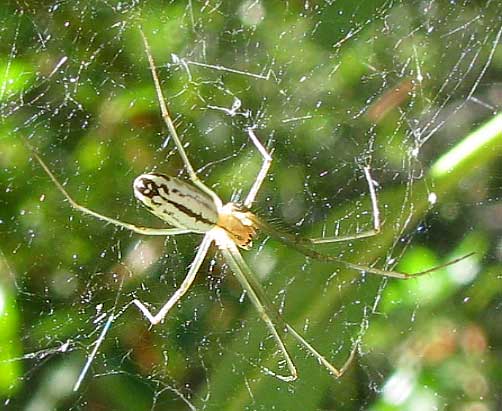Excerpts from Jim Conrad's
Naturalist Newsletter

from the September 6, 2009 Newsletter, issued from the Siskiyou Mountains west of Grants Pass, Oregon:
A SPIDER'S SPICED WEB
The most conspicuous spider here nowadays produces a dome web strung at head level between limbs of bushes along roads and at woods edges. It's the Sierra Dome Spider, NERIENE LITIGIOSA, native to the northwestern US. An upside-down female beneath her dome is shown above.
You can see a close-up ofthe pretty spider herself below:

Sierra Dome Spiders are polyandrous -- females usually mate with more than one male. Females "spice" their webs with male-attracting pheromones. Once male and female meet they engage in 2-6 hours of "pre-insemination copulatory foreplay," copulation consisting of the male inserting his sperm-holding, sink-plunger-like palps (leg-like appendages often serving as "feelers" near the head) into the female. Courtship works up the male so that his metabolic rate rises 1.2-4.5 times his resting rate. Once the session ends the male retires to the web's edge, deposits more sperm into one or both palps, and returns to copulate for another 0.5-1.4 hour, during which 60-120 additional sperm insertions take place. This information is from an online book review of "Cryptic Sexual Selection -- More Control Issues," an article appearing in "Evolution 51(1), 1997, pp. 321-324."
The rambunctious courtship enables the female to judge how vigorous the male is. Females prefer strong fighters. If no exceptional fighters are available, large, vigorous males come next. An abstract of a paper with more detail on mate choice can be read at https://www.ncbi.nlm.nih.gov/pubmed/9480706.
In an effort to be surer that the female accepts their sperm and not the sperm of another male who comes along later, males often destroy much of the female's pheromone-emitting, other-male-attracting web. Of course this isn't helpful to the female, since not only does she want the web to attract more males but also she uses the web to catch her food; she'll have to rebuild it. Information about this species' spiced webs is in the online Google book Sexual Conflict By Arnqvist & Rowe, Princeton University Press, 2005.
Having learned the above details I took a walk looking at every web I could find, maybe a dozen during a half-hour search. Several webs appeared to be empty. One had the dome completely ripped away and in other webs large sections were missing and I wondered whether males had been at their web-wrecking business there. In one, the female sat sucking the juices from what seemed a smaller spider. And in just one, the female waited upside-down beneath her perfect dome, waiting for some action.